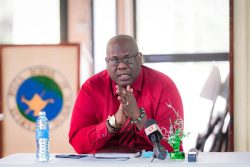Little if any public attention has been paid to the significance of the new US$60m submarine telecommunications cable for relations between the two South American Republics that share the cable and what this might mean for the bettering of a bilateral relationship which, over the years, has been blighted by a bitter controversy over borders.
GT&T and TELESUR, the respective telecommunications service providers for Guyana and Suriname have, over the past two years or so, worked together to realize the single largest joint investment by the two countries. The shared cable matches if not exceeds in its significance the creation of the ferry crossing facility. That apart, by collaborating in the creation of a shared modern telecommunications facility the two companies have provided evidence of what can be achieved if they can find a way of setting their differences aside when opportunities arise for working together for the benefit of their two peoples.
That indeed was the focus of the deliberations on the shared financing of the submarine cable between the two companies which began in 2008. Both parties were clearly preoccupied with the need to create greater bandwidth capacity to further modernize their telecommunications infrastructure and while the reality of a bilateral relationship which, less than a decade earlier, had descended into military aggression could not be ignored, pragmatism won out in the final analysis.
Historically, negotiations between Guyana and Suriname at the level of Joint Commission exchanges have frequently been informed by interludes of testiness and disagreement even over issues that had little or no bearing on their border controversy; and while the telecommunications teams -which reportedly held 15 to 20 meetings to negotiate and discuss – would have been inclined to regard their discourses as simply a matter of business, the negotiating officials could not entirely wish away the overarching ‘difficult’ bilateral climate.
The available evidence suggests that once the idea of the shared submarine cable had been addressed with the governments in Georgetown and Paramaribo, both sides assumed a posture of maturity and realism, recognizing the considerable benefits to be derived from the initiative. The Governments of Guyana and Suriname,” GT&T Chief Executive Officer Yog Mahadeo told Stabroek Business earlier this week, “were unequivocal in their support for the project.” It was simply a matter of putting development before differences.
With the cable now in place Guyana and Suriname have committed themselves to shared responsibility for its maintenance and repairs. GT&T and TELESUR have also agreed to negotiate jointly with upstream providers to collectively secure additional benefits from the new facility. The two telecommunications teams must also work together to ensure the efficient redundancy and are currently pursuing the upgrading of the Americas 11 fibre optic cable.
What all this surely says to us is that while Guyana and Suriname will have to live with their differences for a good deal longer, working together on initiatives that can redound to the collective benefit of the two countries and in the interest of their two peoples is entirely possible. Hopefully, GT&T and TELESUR have set a precedent that will shape attitudes and outlook on both sides of the border whenever future opportunities might arise for working together on projects of mutual benefit to the two countries









